New Era, MI Map & Demographics
New Era Map
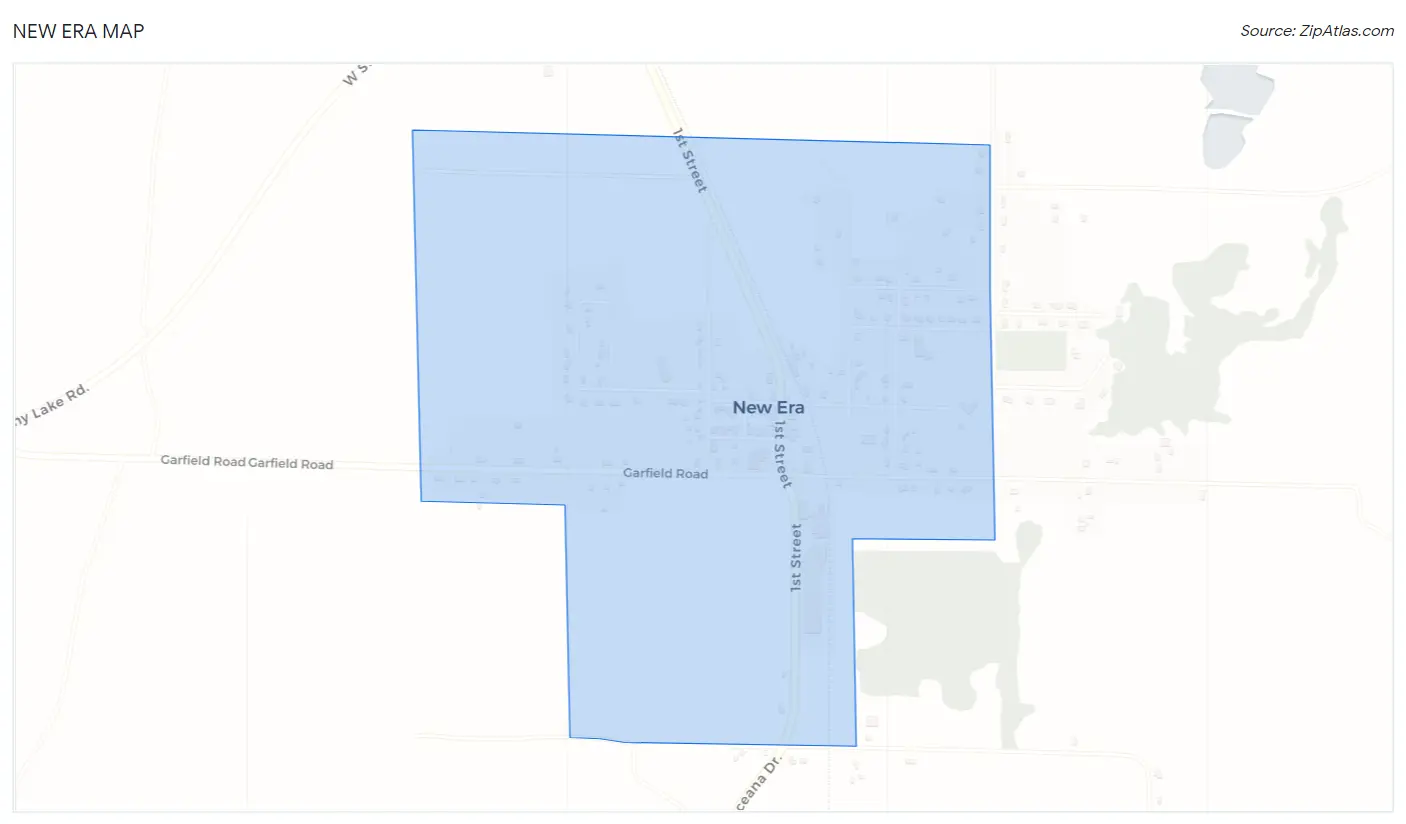
New Era Overview
$37,162
PER CAPITA INCOME
$83,750
AVG FAMILY INCOME
$79,688
AVG HOUSEHOLD INCOME
42.0%
WAGE / INCOME GAP [ % ]
58.0¢/ $1
WAGE / INCOME GAP [ $ ]
0.31
INEQUALITY / GINI INDEX
441
TOTAL POPULATION
215
MALE POPULATION
226
FEMALE POPULATION
95.13
MALES / 100 FEMALES
105.12
FEMALES / 100 MALES
53.8
MEDIAN AGE
2.7
AVG FAMILY SIZE
2.5
AVG HOUSEHOLD SIZE
240
LABOR FORCE [ PEOPLE ]
61.9%
PERCENT IN LABOR FORCE
1.7%
UNEMPLOYMENT RATE
New Era Zip Codes
New Era Area Codes
Income in New Era
Income Overview in New Era
Per Capita Income in New Era is $37,162, while median incomes of families and households are $83,750 and $79,688 respectively.
| Characteristic | Number | Measure |
| Per Capita Income | 441 | $37,162 |
| Median Family Income | 153 | $83,750 |
| Mean Family Income | 153 | $91,990 |
| Median Household Income | 177 | $79,688 |
| Mean Household Income | 177 | $88,056 |
| Income Deficit | 153 | $0 |
| Wage / Income Gap (%) | 441 | 42.05% |
| Wage / Income Gap ($) | 441 | 57.95¢ per $1 |
| Gini / Inequality Index | 441 | 0.31 |
Earnings by Sex in New Era
Average Earnings in New Era are $37,614, $55,000 for men and $31,875 for women, a difference of 42.0%.

| Sex | Number | Average Earnings |
| Male | 124 (48.8%) | $55,000 |
| Female | 130 (51.2%) | $31,875 |
| Total | 254 (100.0%) | $37,614 |
Earnings by Sex by Income Bracket in New Era
The most common earnings brackets in New Era are $65,000 to $74,999 for men (22 | 17.7%) and $35,000 to $39,999 for women (35 | 26.9%).
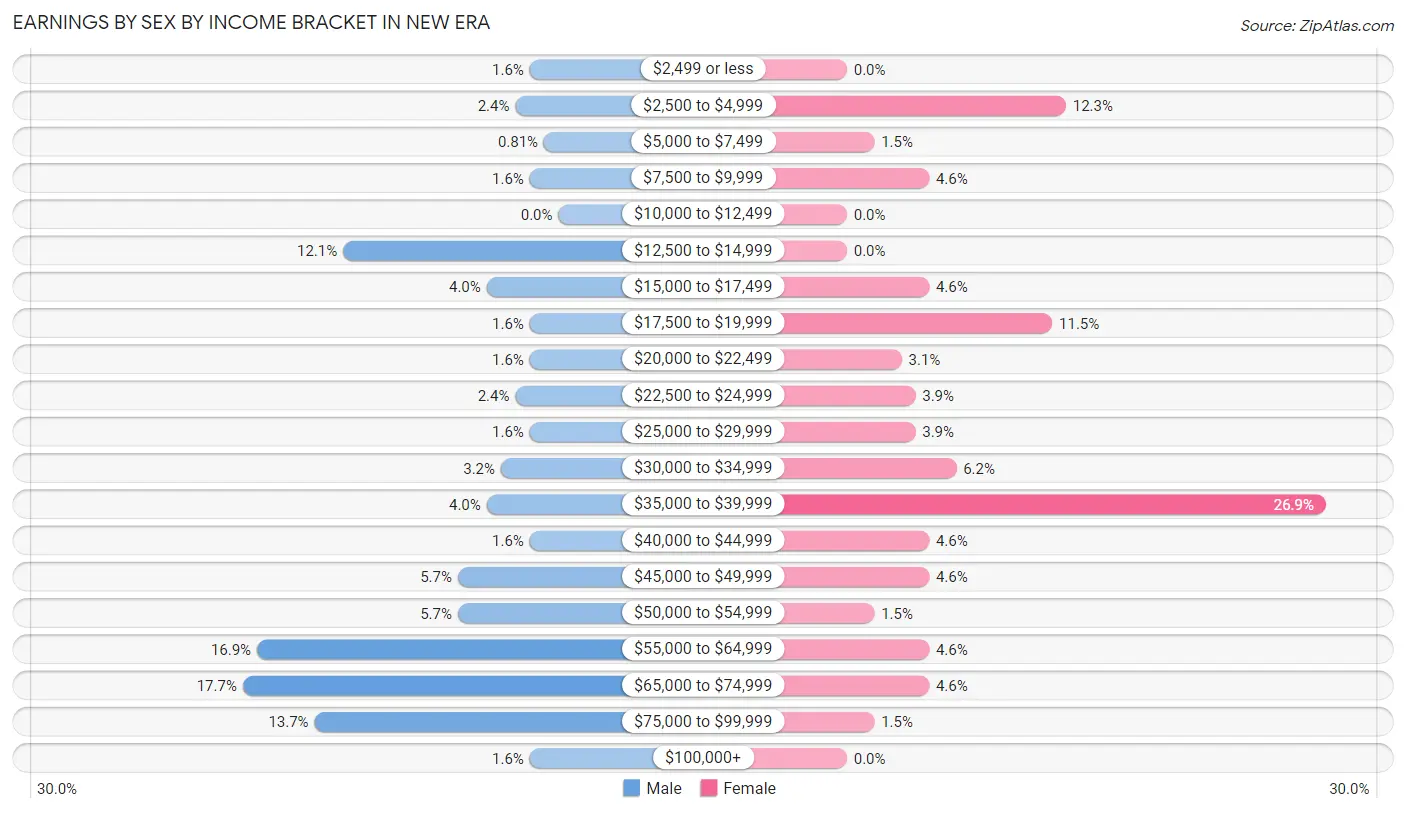
| Income | Male | Female |
| $2,499 or less | 2 (1.6%) | 0 (0.0%) |
| $2,500 to $4,999 | 3 (2.4%) | 16 (12.3%) |
| $5,000 to $7,499 | 1 (0.8%) | 2 (1.5%) |
| $7,500 to $9,999 | 2 (1.6%) | 6 (4.6%) |
| $10,000 to $12,499 | 0 (0.0%) | 0 (0.0%) |
| $12,500 to $14,999 | 15 (12.1%) | 0 (0.0%) |
| $15,000 to $17,499 | 5 (4.0%) | 6 (4.6%) |
| $17,500 to $19,999 | 2 (1.6%) | 15 (11.5%) |
| $20,000 to $22,499 | 2 (1.6%) | 4 (3.1%) |
| $22,500 to $24,999 | 3 (2.4%) | 5 (3.8%) |
| $25,000 to $29,999 | 2 (1.6%) | 5 (3.8%) |
| $30,000 to $34,999 | 4 (3.2%) | 8 (6.1%) |
| $35,000 to $39,999 | 5 (4.0%) | 35 (26.9%) |
| $40,000 to $44,999 | 2 (1.6%) | 6 (4.6%) |
| $45,000 to $49,999 | 7 (5.7%) | 6 (4.6%) |
| $50,000 to $54,999 | 7 (5.7%) | 2 (1.5%) |
| $55,000 to $64,999 | 21 (16.9%) | 6 (4.6%) |
| $65,000 to $74,999 | 22 (17.7%) | 6 (4.6%) |
| $75,000 to $99,999 | 17 (13.7%) | 2 (1.5%) |
| $100,000+ | 2 (1.6%) | 0 (0.0%) |
| Total | 124 (100.0%) | 130 (100.0%) |
Earnings by Sex by Educational Attainment in New Era
Average earnings in New Era are $57,083 for men and $31,250 for women, a difference of 45.3%. Men with an educational attainment of bachelor's degree enjoy the highest average annual earnings of $68,333, while those with high school diploma education earn the least with $49,643. Women with an educational attainment of high school diploma earn the most with the average annual earnings of $38,750, while those with bachelor's degree education have the smallest earnings of $19,417.

| Educational Attainment | Male Income | Female Income |
| Less than High School | - | - |
| High School Diploma | $49,643 | $38,750 |
| College or Associate's Degree | $63,438 | $32,321 |
| Bachelor's Degree | $68,333 | $19,417 |
| Graduate Degree | - | - |
| Total | $57,083 | $31,250 |
Family Income in New Era
Family Income Brackets in New Era
According to the New Era family income data, there are 62 families falling into the $100,000 to $149,999 income range, which is the most common income bracket and makes up 40.5% of all families.

| Income Bracket | # Families | % Families |
| Less than $10,000 | 2 | 1.3% |
| $10,000 to $14,999 | 0 | 0.0% |
| $15,000 to $24,999 | 2 | 1.3% |
| $25,000 to $34,999 | 15 | 9.8% |
| $35,000 to $49,999 | 10 | 6.5% |
| $50,000 to $74,999 | 39 | 25.5% |
| $75,000 to $99,999 | 15 | 9.8% |
| $100,000 to $149,999 | 62 | 40.5% |
| $150,000 to $199,999 | 4 | 2.6% |
| $200,000+ | 4 | 2.6% |
Family Income by Famaliy Size in New Era
3-person families (25 | 16.3%) account for the highest median family income in New Era with $135,625 per family, while 3-person families (25 | 16.3%) have the highest median income of $45,208 per family member.

| Income Bracket | # Families | Median Income |
| 2-Person Families | 99 (64.7%) | $68,438 |
| 3-Person Families | 25 (16.3%) | $135,625 |
| 4-Person Families | 23 (15.0%) | $109,750 |
| 5-Person Families | 5 (3.3%) | $88,750 |
| 6-Person Families | 1 (0.6%) | $0 |
| 7+ Person Families | 0 (0.0%) | $0 |
| Total | 153 (100.0%) | $83,750 |
Family Income by Number of Earners in New Era
The median family income in New Era is $83,750, with families comprising 3+ earners (22) having the highest median family income of $124,643, while families with no earners (33) have the lowest median family income of $43,750, accounting for 14.4% and 21.6% of families, respectively.

| Number of Earners | # Families | Median Income |
| No Earners | 33 (21.6%) | $43,750 |
| 1 Earner | 27 (17.6%) | $65,250 |
| 2 Earners | 71 (46.4%) | $111,875 |
| 3+ Earners | 22 (14.4%) | $124,643 |
| Total | 153 (100.0%) | $83,750 |
Household Income in New Era
Household Income Brackets in New Era
With 66 households falling in the category, the $100,000 to $149,999 income range is the most frequent in New Era, accounting for 37.3% of all households. In contrast, only 2 households (1.1%) fall into the $10,000 to $14,999 income bracket, making it the least populous group.

| Income Bracket | # Households | % Households |
| Less than $10,000 | 4 | 2.3% |
| $10,000 to $14,999 | 2 | 1.1% |
| $15,000 to $24,999 | 4 | 2.3% |
| $25,000 to $34,999 | 19 | 10.7% |
| $35,000 to $49,999 | 14 | 7.9% |
| $50,000 to $74,999 | 42 | 23.7% |
| $75,000 to $99,999 | 15 | 8.5% |
| $100,000 to $149,999 | 66 | 37.3% |
| $150,000 to $199,999 | 7 | 4.0% |
| $200,000+ | 4 | 2.3% |
Household Income by Householder Age in New Era
The median household income in New Era is $79,688, with the highest median household income of $110,000 found in the 45 to 64 years age bracket for the primary householder. A total of 56 households (31.6%) fall into this category. Meanwhile, the 15 to 24 years age bracket for the primary householder has the lowest median household income of $0, with 4 households (2.3%) in this group.

| Income Bracket | # Households | Median Income |
| 15 to 24 Years | 4 (2.3%) | $0 |
| 25 to 44 Years | 29 (16.4%) | $105,625 |
| 45 to 64 Years | 56 (31.6%) | $110,000 |
| 65+ Years | 88 (49.7%) | $65,833 |
| Total | 177 (100.0%) | $79,688 |
Poverty in New Era
Income Below Poverty by Sex and Age in New Era
With 2.8% poverty level for males and 5.8% for females among the residents of New Era, 12 to 14 year old males and 18 to 24 year old females are the most vulnerable to poverty, with 1 males (10.0%) and 4 females (21.0%) in their respective age groups living below the poverty level.
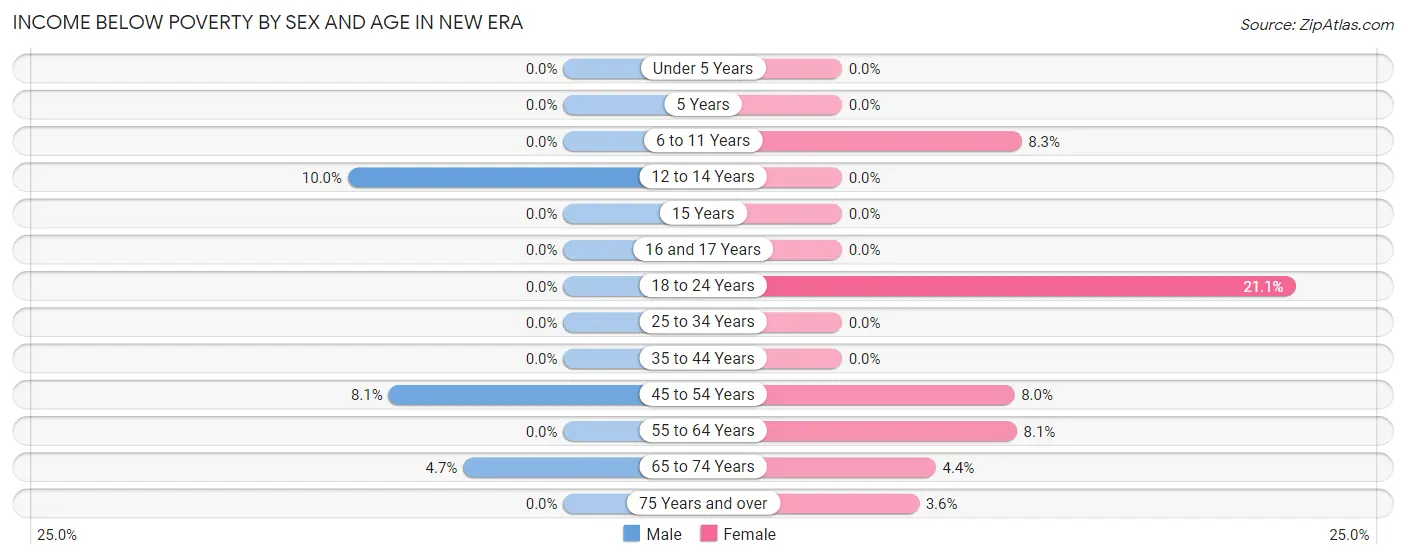
| Age Bracket | Male | Female |
| Under 5 Years | 0 (0.0%) | 0 (0.0%) |
| 5 Years | 0 (0.0%) | 0 (0.0%) |
| 6 to 11 Years | 0 (0.0%) | 1 (8.3%) |
| 12 to 14 Years | 1 (10.0%) | 0 (0.0%) |
| 15 Years | 0 (0.0%) | 0 (0.0%) |
| 16 and 17 Years | 0 (0.0%) | 0 (0.0%) |
| 18 to 24 Years | 0 (0.0%) | 4 (21.0%) |
| 25 to 34 Years | 0 (0.0%) | 0 (0.0%) |
| 35 to 44 Years | 0 (0.0%) | 0 (0.0%) |
| 45 to 54 Years | 3 (8.1%) | 2 (8.0%) |
| 55 to 64 Years | 0 (0.0%) | 3 (8.1%) |
| 65 to 74 Years | 2 (4.6%) | 2 (4.3%) |
| 75 Years and over | 0 (0.0%) | 1 (3.6%) |
| Total | 6 (2.8%) | 13 (5.8%) |
Income Above Poverty by Sex and Age in New Era
According to the poverty statistics in New Era, males aged under 5 years and females aged under 5 years are the age groups that are most secure financially, with 100.0% of males and 100.0% of females in these age groups living above the poverty line.
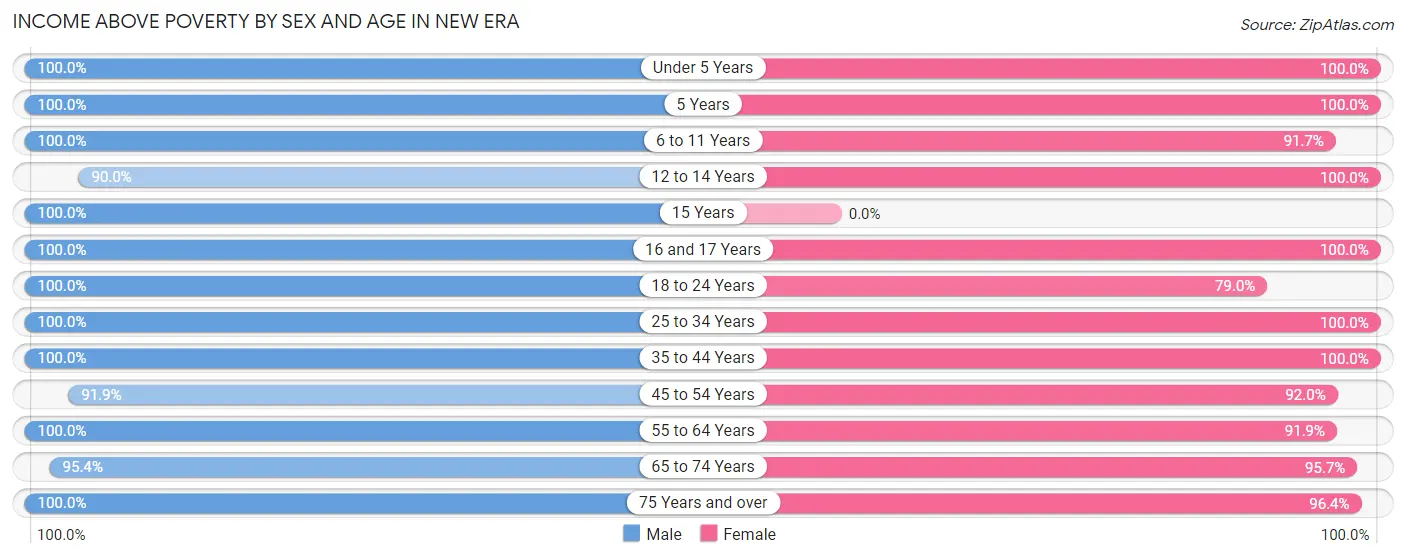
| Age Bracket | Male | Female |
| Under 5 Years | 5 (100.0%) | 2 (100.0%) |
| 5 Years | 2 (100.0%) | 5 (100.0%) |
| 6 to 11 Years | 9 (100.0%) | 11 (91.7%) |
| 12 to 14 Years | 9 (90.0%) | 6 (100.0%) |
| 15 Years | 2 (100.0%) | 0 (0.0%) |
| 16 and 17 Years | 1 (100.0%) | 11 (100.0%) |
| 18 to 24 Years | 13 (100.0%) | 15 (78.9%) |
| 25 to 34 Years | 26 (100.0%) | 17 (100.0%) |
| 35 to 44 Years | 11 (100.0%) | 18 (100.0%) |
| 45 to 54 Years | 34 (91.9%) | 23 (92.0%) |
| 55 to 64 Years | 33 (100.0%) | 34 (91.9%) |
| 65 to 74 Years | 41 (95.4%) | 44 (95.7%) |
| 75 Years and over | 23 (100.0%) | 27 (96.4%) |
| Total | 209 (97.2%) | 213 (94.3%) |
Income Below Poverty Among Married-Couple Families in New Era
The poverty statistics for married-couple families in New Era show that 1.5% or 2 of the total 134 families live below the poverty line. Families with no children have the highest poverty rate of 1.9%, comprising of 2 families. On the other hand, families with 1 or 2 children have the lowest poverty rate of 0.0%, which includes 0 families.

| Children | Above Poverty | Below Poverty |
| No Children | 104 (98.1%) | 2 (1.9%) |
| 1 or 2 Children | 24 (100.0%) | 0 (0.0%) |
| 3 or 4 Children | 4 (100.0%) | 0 (0.0%) |
| 5 or more Children | 0 (0.0%) | 0 (0.0%) |
| Total | 132 (98.5%) | 2 (1.5%) |
Income Below Poverty Among Single-Parent Households in New Era

| Children | Single Father | Single Mother |
| No Children | 0 (0.0%) | 0 (0.0%) |
| 1 or 2 Children | 0 (0.0%) | 2 (22.2%) |
| 3 or 4 Children | 0 (0.0%) | 0 (0.0%) |
| 5 or more Children | 0 (0.0%) | 0 (0.0%) |
| Total | 0 (0.0%) | 2 (13.3%) |
Income Below Poverty Among Married-Couple vs Single-Parent Households in New Era
The poverty data for New Era shows that 2 of the married-couple family households (1.5%) and 2 of the single-parent households (10.5%) are living below the poverty level. Within the married-couple family households, those with no children have the highest poverty rate, with 2 households (1.9%) falling below the poverty line. Among the single-parent households, those with 1 or 2 children have the highest poverty rate, with 2 household (22.2%) living below poverty.

| Children | Married-Couple Families | Single-Parent Households |
| No Children | 2 (1.9%) | 0 (0.0%) |
| 1 or 2 Children | 0 (0.0%) | 2 (22.2%) |
| 3 or 4 Children | 0 (0.0%) | 0 (0.0%) |
| 5 or more Children | 0 (0.0%) | 0 (0.0%) |
| Total | 2 (1.5%) | 2 (10.5%) |
Race in New Era
The most populous races in New Era are White / Caucasian (425 | 96.4%), Hispanic or Latino (28 | 6.4%), and Some other Race (9 | 2.0%).

| Race | # Population | % Population |
| Asian | 0 | 0.0% |
| Black / African American | 0 | 0.0% |
| Hawaiian / Pacific | 0 | 0.0% |
| Hispanic or Latino | 28 | 6.4% |
| Native / Alaskan | 0 | 0.0% |
| White / Caucasian | 425 | 96.4% |
| Two or more Races | 7 | 1.6% |
| Some other Race | 9 | 2.0% |
| Total | 441 | 100.0% |
Ancestry in New Era
The most populous ancestries reported in New Era are German (125 | 28.3%), Dutch (110 | 24.9%), English (71 | 16.1%), Irish (57 | 12.9%), and Mexican (28 | 6.4%), together accounting for 88.7% of all New Era residents.
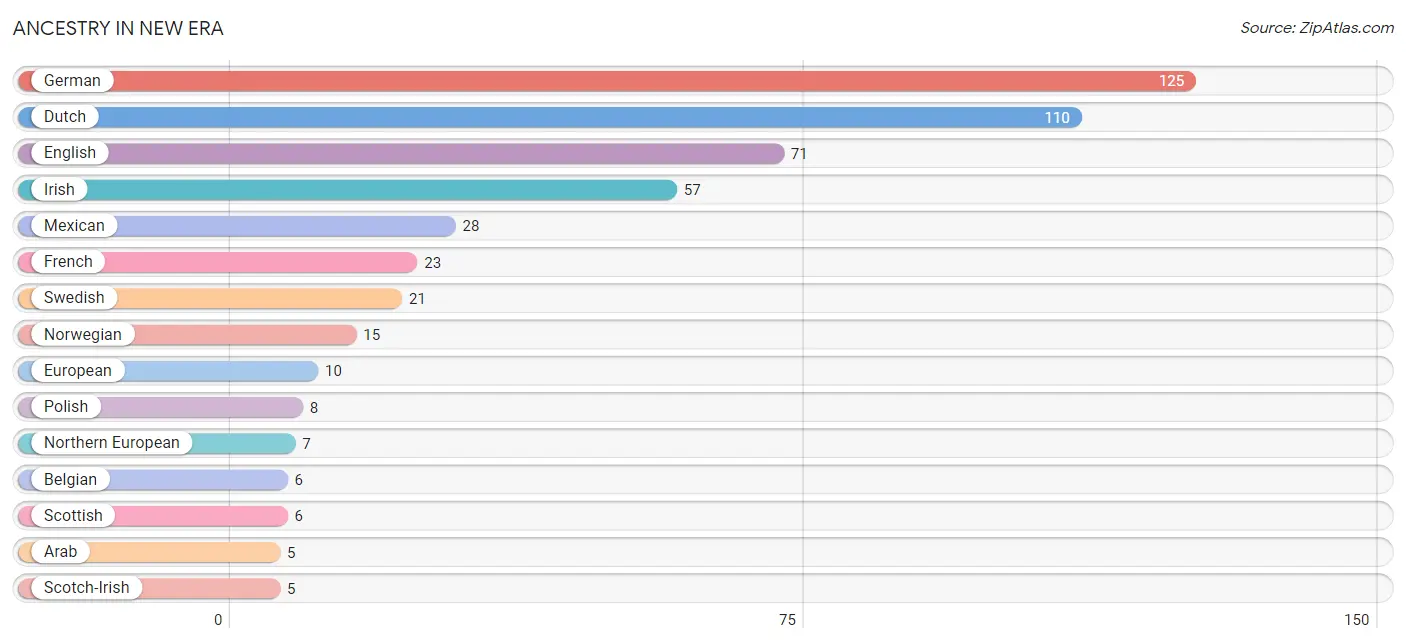
| Ancestry | # Population | % Population |
| American | 4 | 0.9% |
| Arab | 5 | 1.1% |
| Austrian | 1 | 0.2% |
| Belgian | 6 | 1.4% |
| British | 3 | 0.7% |
| Czech | 2 | 0.4% |
| Czechoslovakian | 1 | 0.2% |
| Danish | 2 | 0.4% |
| Dutch | 110 | 24.9% |
| English | 71 | 16.1% |
| European | 10 | 2.3% |
| French | 23 | 5.2% |
| German | 125 | 28.3% |
| Irish | 57 | 12.9% |
| Italian | 2 | 0.4% |
| Korean | 1 | 0.2% |
| Mexican | 28 | 6.4% |
| Northern European | 7 | 1.6% |
| Norwegian | 15 | 3.4% |
| Pennsylvania German | 2 | 0.4% |
| Polish | 8 | 1.8% |
| Scotch-Irish | 5 | 1.1% |
| Scottish | 6 | 1.4% |
| Slavic | 2 | 0.4% |
| Swedish | 21 | 4.8% |
| Syrian | 5 | 1.1% |
| Welsh | 1 | 0.2% |
| Yugoslavian | 2 | 0.4% | View All 28 Rows |
Immigrants in New Era
The most numerous immigrant groups reported in New Era came from Central America (2 | 0.4%), Latin America (2 | 0.4%), Mexico (2 | 0.4%), England (1 | 0.2%), and Europe (1 | 0.2%), together accounting for 1.8% of all New Era residents.

| Immigration Origin | # Population | % Population |
| Central America | 2 | 0.4% |
| England | 1 | 0.2% |
| Europe | 1 | 0.2% |
| Latin America | 2 | 0.4% |
| Mexico | 2 | 0.4% |
| Northern Europe | 1 | 0.2% | View All 6 Rows |
Sex and Age in New Era
Sex and Age in New Era
The most populous age groups in New Era are 50 to 54 Years (34 | 15.8%) for men and 70 to 74 Years (25 | 11.1%) for women.
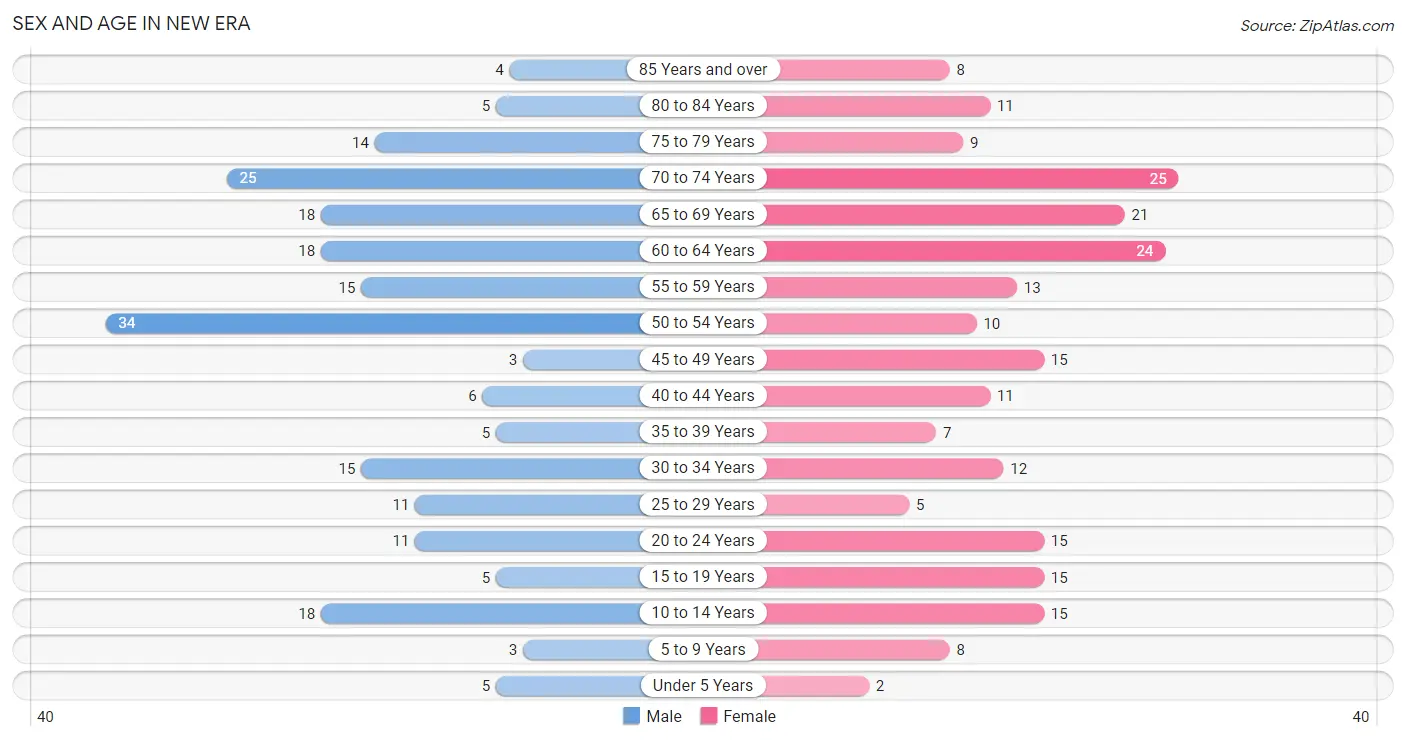
| Age Bracket | Male | Female |
| Under 5 Years | 5 (2.3%) | 2 (0.9%) |
| 5 to 9 Years | 3 (1.4%) | 8 (3.5%) |
| 10 to 14 Years | 18 (8.4%) | 15 (6.6%) |
| 15 to 19 Years | 5 (2.3%) | 15 (6.6%) |
| 20 to 24 Years | 11 (5.1%) | 15 (6.6%) |
| 25 to 29 Years | 11 (5.1%) | 5 (2.2%) |
| 30 to 34 Years | 15 (7.0%) | 12 (5.3%) |
| 35 to 39 Years | 5 (2.3%) | 7 (3.1%) |
| 40 to 44 Years | 6 (2.8%) | 11 (4.9%) |
| 45 to 49 Years | 3 (1.4%) | 15 (6.6%) |
| 50 to 54 Years | 34 (15.8%) | 10 (4.4%) |
| 55 to 59 Years | 15 (7.0%) | 13 (5.8%) |
| 60 to 64 Years | 18 (8.4%) | 24 (10.6%) |
| 65 to 69 Years | 18 (8.4%) | 21 (9.3%) |
| 70 to 74 Years | 25 (11.6%) | 25 (11.1%) |
| 75 to 79 Years | 14 (6.5%) | 9 (4.0%) |
| 80 to 84 Years | 5 (2.3%) | 11 (4.9%) |
| 85 Years and over | 4 (1.9%) | 8 (3.5%) |
| Total | 215 (100.0%) | 226 (100.0%) |
Families and Households in New Era
Median Family Size in New Era
The median family size in New Era is 2.68 persons per family, with single female/mother families (15 | 9.8%) accounting for the largest median family size of 3.07 persons per family. On the other hand, single male/father families (4 | 2.6%) represent the smallest median family size with 2.50 persons per family.

| Family Type | # Families | Family Size |
| Married-Couple | 134 (87.6%) | 2.64 |
| Single Male/Father | 4 (2.6%) | 2.50 |
| Single Female/Mother | 15 (9.8%) | 3.07 |
| Total Families | 153 (100.0%) | 2.68 |
Median Household Size in New Era
The median household size in New Era is 2.49 persons per household, with single female/mother households (15 | 8.5%) accounting for the largest median household size of 3.4 persons per household. non-family households (24 | 13.6%) represent the smallest median household size with 1.08 persons per household.

| Household Type | # Households | Household Size |
| Married-Couple | 134 (75.7%) | 2.64 |
| Single Male/Father | 4 (2.3%) | 2.50 |
| Single Female/Mother | 15 (8.5%) | 3.40 |
| Non-family | 24 (13.6%) | 1.08 |
| Total Households | 177 (100.0%) | 2.49 |
Household Size by Marriage Status in New Era
Out of a total of 177 households in New Era, 153 (86.4%) are family households, while 24 (13.6%) are nonfamily households. The most numerous type of family households are 2-person households, comprising 98, and the most common type of nonfamily households are 1-person households, comprising 22.

| Household Size | Family Households | Nonfamily Households |
| 1-Person Households | - | 22 (12.4%) |
| 2-Person Households | 98 (55.4%) | 2 (1.1%) |
| 3-Person Households | 26 (14.7%) | 0 (0.0%) |
| 4-Person Households | 21 (11.9%) | 0 (0.0%) |
| 5-Person Households | 7 (4.0%) | 0 (0.0%) |
| 6-Person Households | 1 (0.6%) | 0 (0.0%) |
| 7+ Person Households | 0 (0.0%) | 0 (0.0%) |
| Total | 153 (86.4%) | 24 (13.6%) |
Female Fertility in New Era
Fertility by Age in New Era
Average fertility rate in New Era is 38.0 births per 1,000 women. Women in the age bracket of 20 to 34 years have the highest fertility rate with 63.0 births per 1,000 women. Women in the age bracket of 20 to 34 years acount for 66.7% of all women with births.

| Age Bracket | Women with Births | Births / 1,000 Women |
| 15 to 19 years | 0 (0.0%) | 0.0 |
| 20 to 34 years | 2 (66.7%) | 63.0 |
| 35 to 50 years | 1 (33.3%) | 30.0 |
| Total | 3 (100.0%) | 38.0 |
Fertility by Age by Marriage Status in New Era

| Age Bracket | Married | Unmarried |
| 15 to 19 years | 0 (0.0%) | 0 (0.0%) |
| 20 to 34 years | 2 (100.0%) | 0 (0.0%) |
| 35 to 50 years | 1 (100.0%) | 0 (0.0%) |
| Total | 3 (100.0%) | 0 (0.0%) |
Fertility by Education in New Era
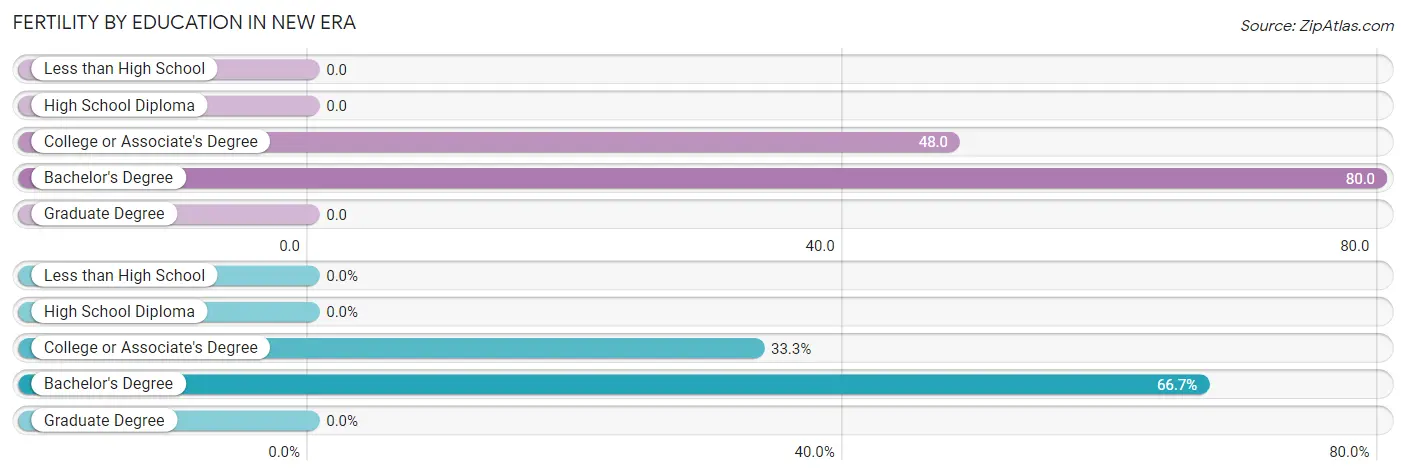
| Educational Attainment | Women with Births | Births / 1,000 Women |
| Less than High School | 0 (0.0%) | 0.0 |
| High School Diploma | 0 (0.0%) | 0.0 |
| College or Associate's Degree | 1 (33.3%) | 48.0 |
| Bachelor's Degree | 2 (66.7%) | 80.0 |
| Graduate Degree | 0 (0.0%) | 0.0 |
| Total | 3 (100.0%) | 38.0 |
Fertility by Education by Marriage Status in New Era

| Educational Attainment | Married | Unmarried |
| Less than High School | 0 (0.0%) | 0 (0.0%) |
| High School Diploma | 0 (0.0%) | 0 (0.0%) |
| College or Associate's Degree | 1 (100.0%) | 0 (0.0%) |
| Bachelor's Degree | 2 (100.0%) | 0 (0.0%) |
| Graduate Degree | 0 (0.0%) | 0 (0.0%) |
| Total | 3 (100.0%) | 0 (0.0%) |
Employment Characteristics in New Era
Employment by Class of Employer in New Era
Among the 236 employed individuals in New Era, private company employees (128 | 54.2%), local government employees (48 | 20.3%), and not-for-profit organizations (24 | 10.2%) make up the most common classes of employment.

| Employer Class | # Employees | % Employees |
| Private Company Employees | 128 | 54.2% |
| Self-Employed (Incorporated) | 7 | 3.0% |
| Self-Employed (Not Incorporated) | 19 | 8.1% |
| Not-for-profit Organizations | 24 | 10.2% |
| Local Government Employees | 48 | 20.3% |
| State Government Employees | 6 | 2.5% |
| Federal Government Employees | 4 | 1.7% |
| Unpaid Family Workers | 0 | 0.0% |
| Total | 236 | 100.0% |
Employment Status by Age in New Era
According to the labor force statistics for New Era, out of the total population over 16 years of age (388), 61.9% or 240 individuals are in the labor force, with 1.7% or 4 of them unemployed. The age group with the highest labor force participation rate is 30 to 34 years, with 100.0% or 27 individuals in the labor force. Within the labor force, the 20 to 24 years age range has the highest percentage of unemployed individuals, with 9.5% or 2 of them being unemployed.

| Age Bracket | In Labor Force | Unemployed |
| 16 to 19 Years | 5 (27.8%) | 0 (0.0%) |
| 20 to 24 Years | 21 (80.8%) | 2 (9.5%) |
| 25 to 29 Years | 14 (87.5%) | 0 (0.0%) |
| 30 to 34 Years | 27 (100.0%) | 0 (0.0%) |
| 35 to 44 Years | 29 (100.0%) | 0 (0.0%) |
| 45 to 54 Years | 55 (88.7%) | 0 (0.0%) |
| 55 to 59 Years | 24 (85.7%) | 2 (8.3%) |
| 60 to 64 Years | 17 (40.5%) | 0 (0.0%) |
| 65 to 74 Years | 45 (50.6%) | 0 (0.0%) |
| 75 Years and over | 3 (5.9%) | 0 (0.0%) |
| Total | 240 (61.9%) | 4 (1.7%) |
Employment Status by Educational Attainment in New Era
According to labor force statistics for New Era, 81.4% of individuals (166) out of the total population between 25 and 64 years of age (204) are in the labor force, with 1.2% or 2 of them being unemployed. The group with the highest labor force participation rate are those with the educational attainment of bachelor's degree or higher, with 91.7% or 55 individuals in the labor force. Within the labor force, individuals with high school diploma education have the highest percentage of unemployment, with 4.9% or 2 of them being unemployed.

| Educational Attainment | In Labor Force | Unemployed |
| Less than High School | 5 (50.0%) | 0 (0.0%) |
| High School Diploma | 41 (71.9%) | 3 (4.9%) |
| College / Associate Degree | 65 (84.4%) | 0 (0.0%) |
| Bachelor's Degree or higher | 55 (91.7%) | 0 (0.0%) |
| Total | 166 (81.4%) | 2 (1.2%) |
Employment Occupations by Sex in New Era
Management, Business, Science and Arts Occupations
The most common Management, Business, Science and Arts occupations in New Era are Community & Social Service (49 | 20.8%), Management (41 | 17.4%), Education Instruction & Library (26 | 11.0%), Education, Arts & Media (12 | 5.1%), and Arts, Media & Entertainment (11 | 4.7%).
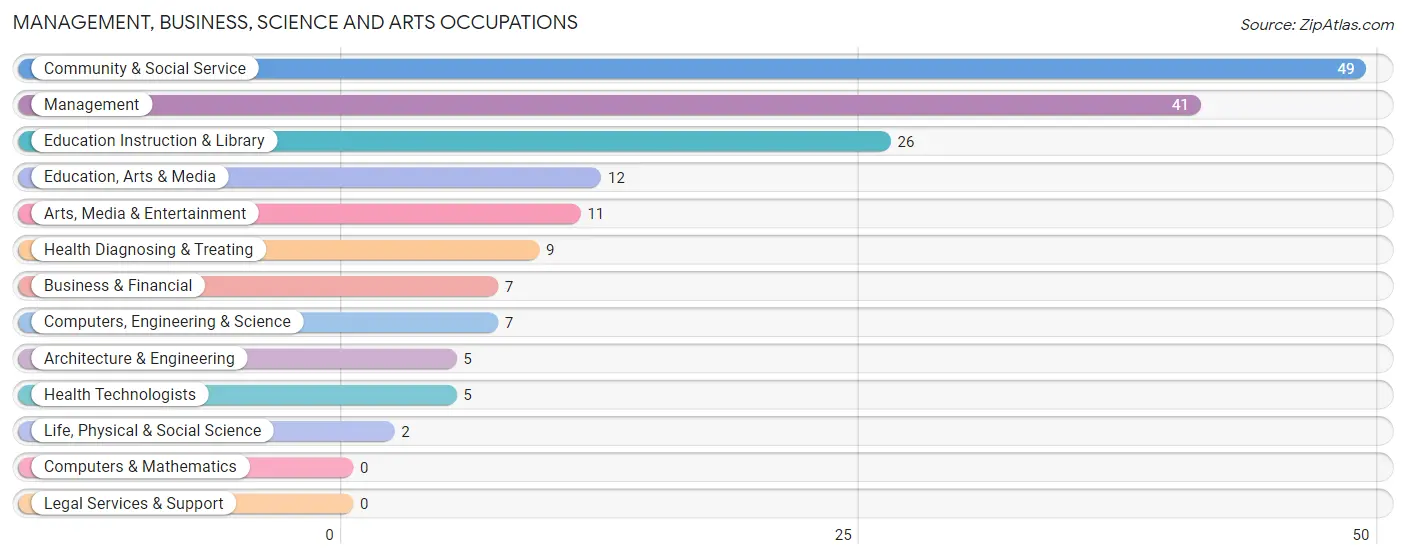
Management, Business, Science and Arts Occupations by Sex
Within the Management, Business, Science and Arts occupations in New Era, the most male-oriented occupations are Computers, Engineering & Science (100.0%), Architecture & Engineering (100.0%), and Life, Physical & Social Science (100.0%), while the most female-oriented occupations are Arts, Media & Entertainment (100.0%), Education Instruction & Library (80.8%), and Health Technologists (80.0%).
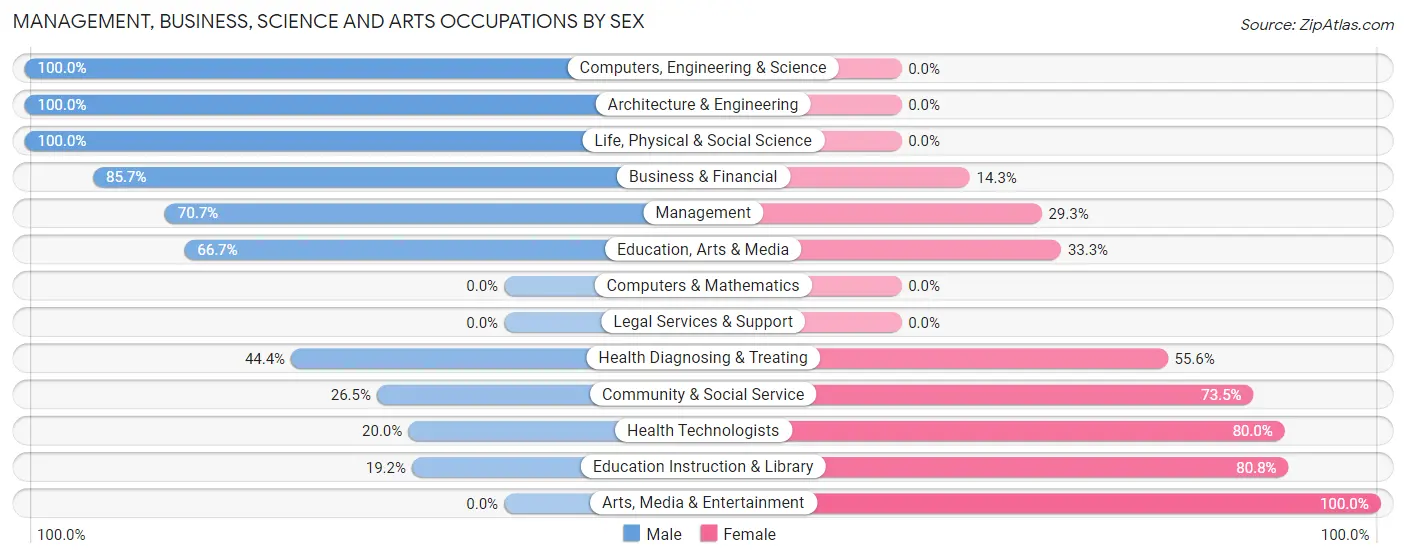
| Occupation | Male | Female |
| Management | 29 (70.7%) | 12 (29.3%) |
| Business & Financial | 6 (85.7%) | 1 (14.3%) |
| Computers, Engineering & Science | 7 (100.0%) | 0 (0.0%) |
| Computers & Mathematics | 0 (0.0%) | 0 (0.0%) |
| Architecture & Engineering | 5 (100.0%) | 0 (0.0%) |
| Life, Physical & Social Science | 2 (100.0%) | 0 (0.0%) |
| Community & Social Service | 13 (26.5%) | 36 (73.5%) |
| Education, Arts & Media | 8 (66.7%) | 4 (33.3%) |
| Legal Services & Support | 0 (0.0%) | 0 (0.0%) |
| Education Instruction & Library | 5 (19.2%) | 21 (80.8%) |
| Arts, Media & Entertainment | 0 (0.0%) | 11 (100.0%) |
| Health Diagnosing & Treating | 4 (44.4%) | 5 (55.6%) |
| Health Technologists | 1 (20.0%) | 4 (80.0%) |
| Total (Category) | 59 (52.2%) | 54 (47.8%) |
| Total (Overall) | 113 (47.9%) | 123 (52.1%) |
Services Occupations
The most common Services occupations in New Era are Healthcare Support (11 | 4.7%), Security & Protection (11 | 4.7%), Law Enforcement (11 | 4.7%), Personal Care & Service (10 | 4.2%), and Food Preparation & Serving (2 | 0.9%).

Services Occupations by Sex
Within the Services occupations in New Era, the most male-oriented occupations are Security & Protection (100.0%), and Law Enforcement (100.0%), while the most female-oriented occupations are Healthcare Support (100.0%), Food Preparation & Serving (100.0%), and Personal Care & Service (100.0%).

| Occupation | Male | Female |
| Healthcare Support | 0 (0.0%) | 11 (100.0%) |
| Security & Protection | 11 (100.0%) | 0 (0.0%) |
| Firefighting & Prevention | 0 (0.0%) | 0 (0.0%) |
| Law Enforcement | 11 (100.0%) | 0 (0.0%) |
| Food Preparation & Serving | 0 (0.0%) | 2 (100.0%) |
| Cleaning & Maintenance | 0 (0.0%) | 0 (0.0%) |
| Personal Care & Service | 0 (0.0%) | 10 (100.0%) |
| Total (Category) | 11 (32.4%) | 23 (67.6%) |
| Total (Overall) | 113 (47.9%) | 123 (52.1%) |
Sales and Office Occupations
The most common Sales and Office occupations in New Era are Sales & Related (34 | 14.4%), and Office & Administration (18 | 7.6%).

Sales and Office Occupations by Sex

| Occupation | Male | Female |
| Sales & Related | 12 (35.3%) | 22 (64.7%) |
| Office & Administration | 2 (11.1%) | 16 (88.9%) |
| Total (Category) | 14 (26.9%) | 38 (73.1%) |
| Total (Overall) | 113 (47.9%) | 123 (52.1%) |
Natural Resources, Construction and Maintenance Occupations
The most common Natural Resources, Construction and Maintenance occupations in New Era are Construction & Extraction (2 | 0.9%), and Farming, Fishing & Forestry (1 | 0.4%).

Natural Resources, Construction and Maintenance Occupations by Sex

| Occupation | Male | Female |
| Farming, Fishing & Forestry | 1 (100.0%) | 0 (0.0%) |
| Construction & Extraction | 2 (100.0%) | 0 (0.0%) |
| Installation, Maintenance & Repair | 0 (0.0%) | 0 (0.0%) |
| Total (Category) | 3 (100.0%) | 0 (0.0%) |
| Total (Overall) | 113 (47.9%) | 123 (52.1%) |
Production, Transportation and Moving Occupations
The most common Production, Transportation and Moving occupations in New Era are Production (24 | 10.2%), Transportation (6 | 2.5%), and Material Moving (4 | 1.7%).

Production, Transportation and Moving Occupations by Sex

| Occupation | Male | Female |
| Production | 16 (66.7%) | 8 (33.3%) |
| Transportation | 6 (100.0%) | 0 (0.0%) |
| Material Moving | 4 (100.0%) | 0 (0.0%) |
| Total (Category) | 26 (76.5%) | 8 (23.5%) |
| Total (Overall) | 113 (47.9%) | 123 (52.1%) |
Employment Industries by Sex in New Era
Employment Industries in New Era
The major employment industries in New Era include Manufacturing (42 | 17.8%), Educational Services (37 | 15.7%), Health Care & Social Assistance (33 | 14.0%), Retail Trade (25 | 10.6%), and Public Administration (18 | 7.6%).
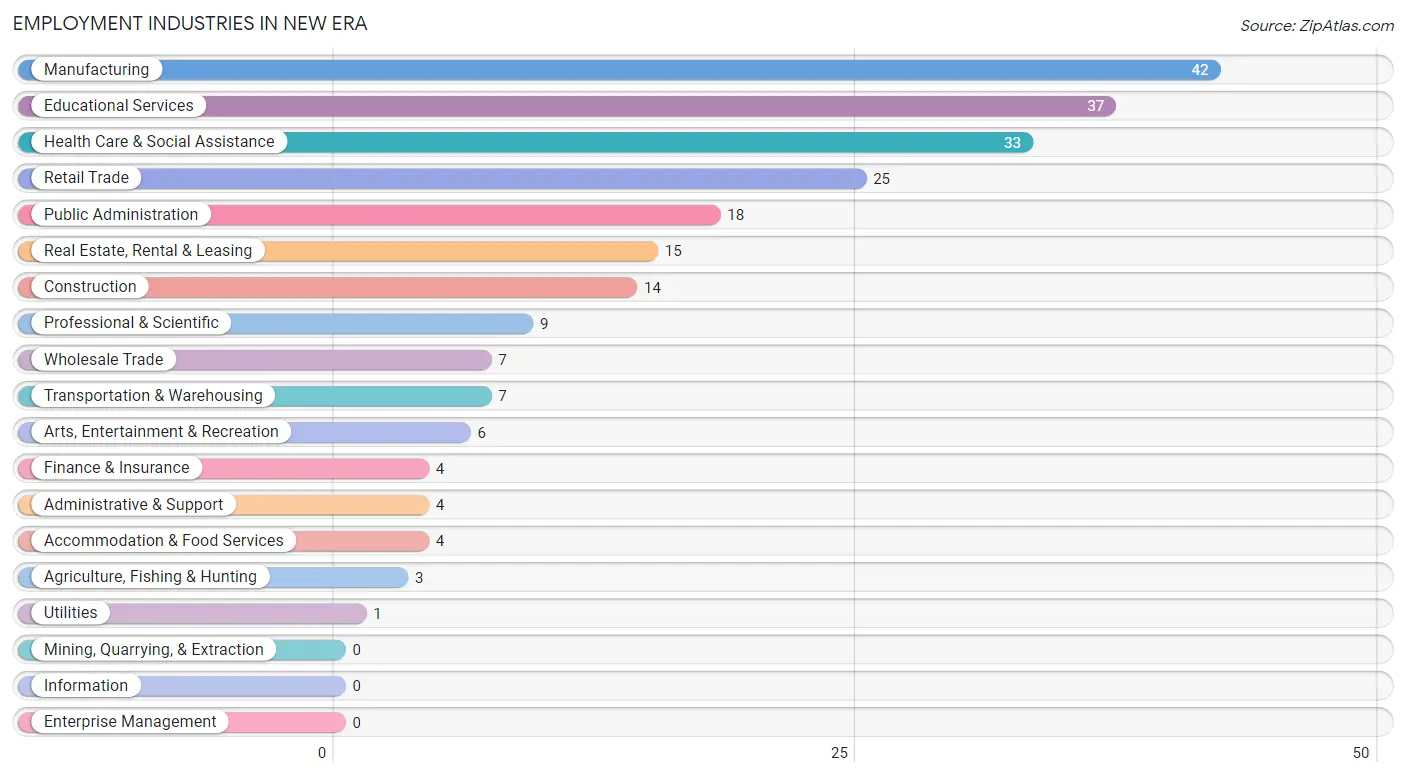
Employment Industries by Sex in New Era
The New Era industries that see more men than women are Construction (100.0%), Wholesale Trade (100.0%), and Utilities (100.0%), whereas the industries that tend to have a higher number of women are Finance & Insurance (100.0%), Real Estate, Rental & Leasing (100.0%), and Health Care & Social Assistance (84.9%).
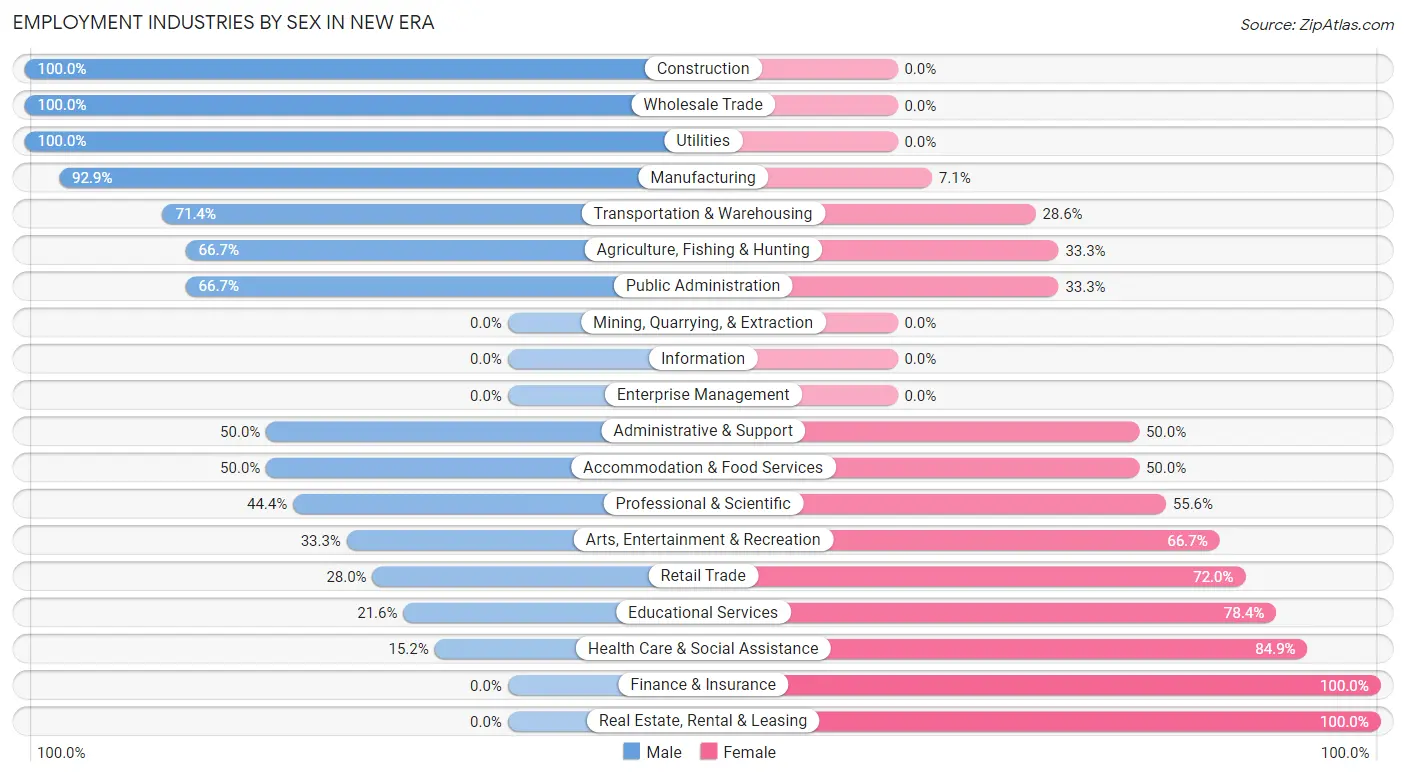
| Industry | Male | Female |
| Agriculture, Fishing & Hunting | 2 (66.7%) | 1 (33.3%) |
| Mining, Quarrying, & Extraction | 0 (0.0%) | 0 (0.0%) |
| Construction | 14 (100.0%) | 0 (0.0%) |
| Manufacturing | 39 (92.9%) | 3 (7.1%) |
| Wholesale Trade | 7 (100.0%) | 0 (0.0%) |
| Retail Trade | 7 (28.0%) | 18 (72.0%) |
| Transportation & Warehousing | 5 (71.4%) | 2 (28.6%) |
| Utilities | 1 (100.0%) | 0 (0.0%) |
| Information | 0 (0.0%) | 0 (0.0%) |
| Finance & Insurance | 0 (0.0%) | 4 (100.0%) |
| Real Estate, Rental & Leasing | 0 (0.0%) | 15 (100.0%) |
| Professional & Scientific | 4 (44.4%) | 5 (55.6%) |
| Enterprise Management | 0 (0.0%) | 0 (0.0%) |
| Administrative & Support | 2 (50.0%) | 2 (50.0%) |
| Educational Services | 8 (21.6%) | 29 (78.4%) |
| Health Care & Social Assistance | 5 (15.1%) | 28 (84.9%) |
| Arts, Entertainment & Recreation | 2 (33.3%) | 4 (66.7%) |
| Accommodation & Food Services | 2 (50.0%) | 2 (50.0%) |
| Public Administration | 12 (66.7%) | 6 (33.3%) |
| Total | 113 (47.9%) | 123 (52.1%) |
Education in New Era
School Enrollment in New Era
The most common levels of schooling among the 71 students in New Era are high school (26 | 36.6%), middle school (19 | 26.8%), and elementary school (11 | 15.5%).

| School Level | # Students | % Students |
| Nursery / Preschool | 0 | 0.0% |
| Kindergarten | 5 | 7.0% |
| Elementary School | 11 | 15.5% |
| Middle School | 19 | 26.8% |
| High School | 26 | 36.6% |
| College / Undergraduate | 7 | 9.9% |
| Graduate / Professional | 3 | 4.2% |
| Total | 71 | 100.0% |
School Enrollment by Age by Funding Source in New Era
Out of a total of 71 students who are enrolled in schools in New Era, 4 (5.6%) attend a private institution, while the remaining 67 (94.4%) are enrolled in public schools. The age group of 20 to 24 year olds has the highest likelihood of being enrolled in private schools, with 2 (40.0% in the age bracket) enrolled. Conversely, the age group of 5 to 9 year old has the lowest likelihood of being enrolled in a private school, with 9 (100.0% in the age bracket) attending a public institution.

| Age Bracket | Public School | Private School |
| 3 to 4 Year Olds | 0 (0.0%) | 0 (0.0%) |
| 5 to 9 Year Old | 9 (100.0%) | 0 (0.0%) |
| 10 to 14 Year Olds | 31 (96.9%) | 1 (3.1%) |
| 15 to 17 Year Olds | 14 (100.0%) | 0 (0.0%) |
| 18 to 19 Year Olds | 6 (100.0%) | 0 (0.0%) |
| 20 to 24 Year Olds | 3 (60.0%) | 2 (40.0%) |
| 25 to 34 Year Olds | 2 (66.7%) | 1 (33.3%) |
| 35 Years and over | 2 (100.0%) | 0 (0.0%) |
| Total | 67 (94.4%) | 4 (5.6%) |
Educational Attainment by Field of Study in New Era
Education (47 | 30.9%), science & technology (41 | 27.0%), business (13 | 8.6%), arts & humanities (11 | 7.2%), and liberal arts & history (10 | 6.6%) are the most common fields of study among 152 individuals in New Era who have obtained a bachelor's degree or higher.
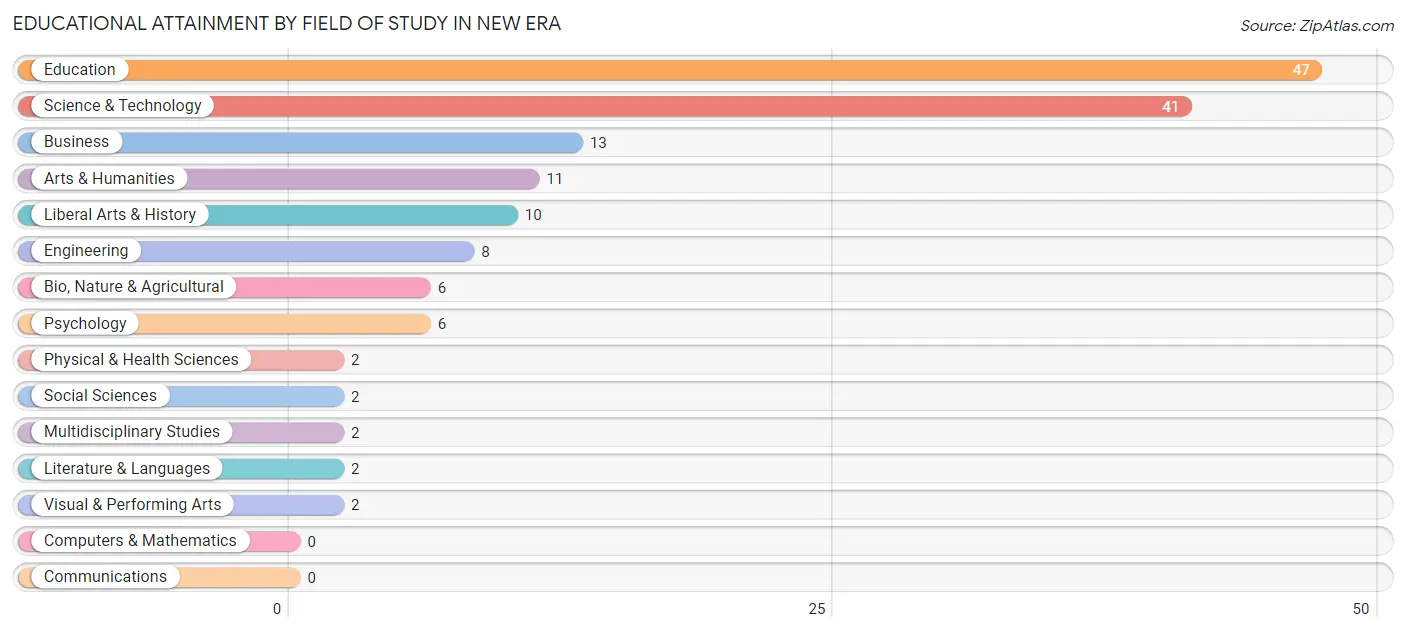
| Field of Study | # Graduates | % Graduates |
| Computers & Mathematics | 0 | 0.0% |
| Bio, Nature & Agricultural | 6 | 4.0% |
| Physical & Health Sciences | 2 | 1.3% |
| Psychology | 6 | 4.0% |
| Social Sciences | 2 | 1.3% |
| Engineering | 8 | 5.3% |
| Multidisciplinary Studies | 2 | 1.3% |
| Science & Technology | 41 | 27.0% |
| Business | 13 | 8.6% |
| Education | 47 | 30.9% |
| Literature & Languages | 2 | 1.3% |
| Liberal Arts & History | 10 | 6.6% |
| Visual & Performing Arts | 2 | 1.3% |
| Communications | 0 | 0.0% |
| Arts & Humanities | 11 | 7.2% |
| Total | 152 | 100.0% |
Transportation & Commute in New Era
Vehicle Availability by Sex in New Era
The most prevalent vehicle ownership categories in New Era are males with 2 vehicles (46, accounting for 40.7%) and females with 2 vehicles (69, making up 37.4%).

| Vehicles Available | Male | Female |
| No Vehicle | 1 (0.9%) | 2 (1.6%) |
| 1 Vehicle | 10 (8.8%) | 5 (4.1%) |
| 2 Vehicles | 46 (40.7%) | 69 (56.1%) |
| 3 Vehicles | 43 (38.1%) | 27 (22.0%) |
| 4 Vehicles | 13 (11.5%) | 20 (16.3%) |
| 5 or more Vehicles | 0 (0.0%) | 0 (0.0%) |
| Total | 113 (100.0%) | 123 (100.0%) |
Commute Time in New Era
The most frequently occuring commute durations in New Era are 20 to 24 minutes (43 commuters, 20.2%), 5 to 9 minutes (38 commuters, 17.8%), and 15 to 19 minutes (32 commuters, 15.0%).
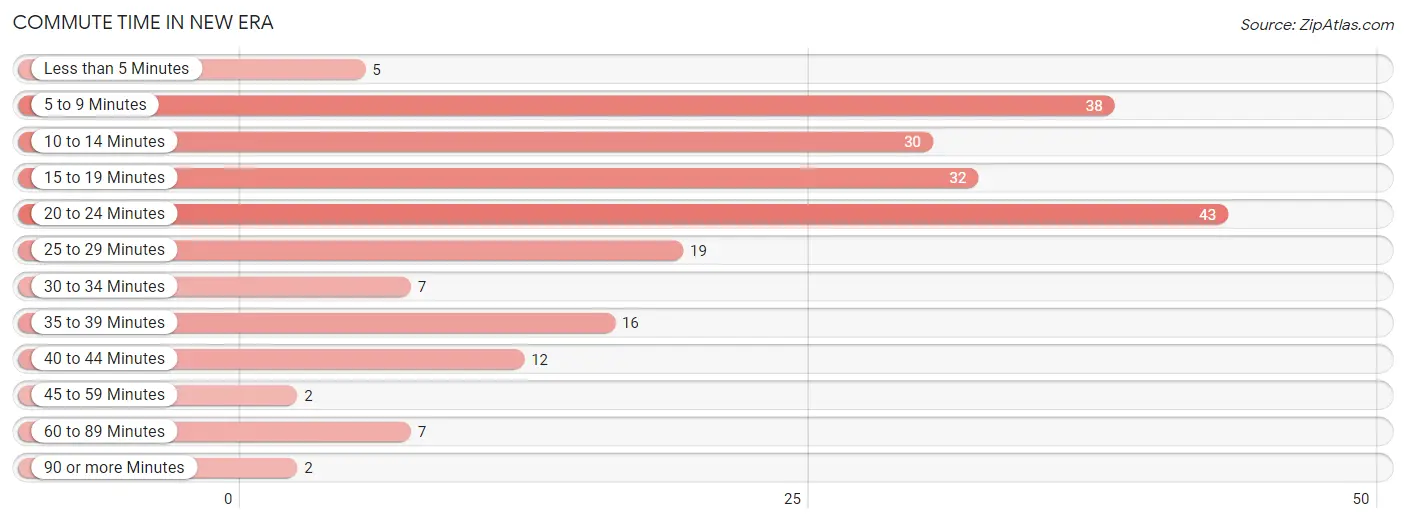
| Commute Time | # Commuters | % Commuters |
| Less than 5 Minutes | 5 | 2.4% |
| 5 to 9 Minutes | 38 | 17.8% |
| 10 to 14 Minutes | 30 | 14.1% |
| 15 to 19 Minutes | 32 | 15.0% |
| 20 to 24 Minutes | 43 | 20.2% |
| 25 to 29 Minutes | 19 | 8.9% |
| 30 to 34 Minutes | 7 | 3.3% |
| 35 to 39 Minutes | 16 | 7.5% |
| 40 to 44 Minutes | 12 | 5.6% |
| 45 to 59 Minutes | 2 | 0.9% |
| 60 to 89 Minutes | 7 | 3.3% |
| 90 or more Minutes | 2 | 0.9% |
Commute Time by Sex in New Era
The most common commute times in New Era are 20 to 24 minutes (26 commuters, 24.1%) for males and 5 to 9 minutes (25 commuters, 23.8%) for females.
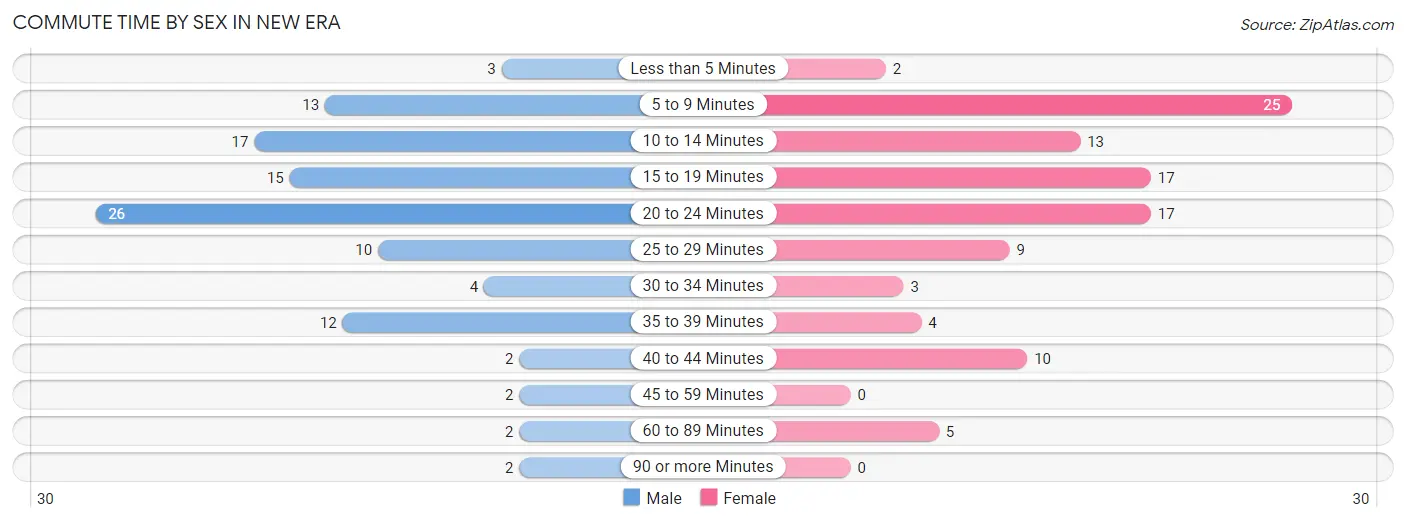
| Commute Time | Male | Female |
| Less than 5 Minutes | 3 (2.8%) | 2 (1.9%) |
| 5 to 9 Minutes | 13 (12.0%) | 25 (23.8%) |
| 10 to 14 Minutes | 17 (15.7%) | 13 (12.4%) |
| 15 to 19 Minutes | 15 (13.9%) | 17 (16.2%) |
| 20 to 24 Minutes | 26 (24.1%) | 17 (16.2%) |
| 25 to 29 Minutes | 10 (9.3%) | 9 (8.6%) |
| 30 to 34 Minutes | 4 (3.7%) | 3 (2.9%) |
| 35 to 39 Minutes | 12 (11.1%) | 4 (3.8%) |
| 40 to 44 Minutes | 2 (1.8%) | 10 (9.5%) |
| 45 to 59 Minutes | 2 (1.8%) | 0 (0.0%) |
| 60 to 89 Minutes | 2 (1.8%) | 5 (4.8%) |
| 90 or more Minutes | 2 (1.8%) | 0 (0.0%) |
Time of Departure to Work by Sex in New Era
The most frequent times of departure to work in New Era are 6:30 AM to 6:59 AM (22, 20.4%) for males and 6:30 AM to 6:59 AM (31, 29.5%) for females.
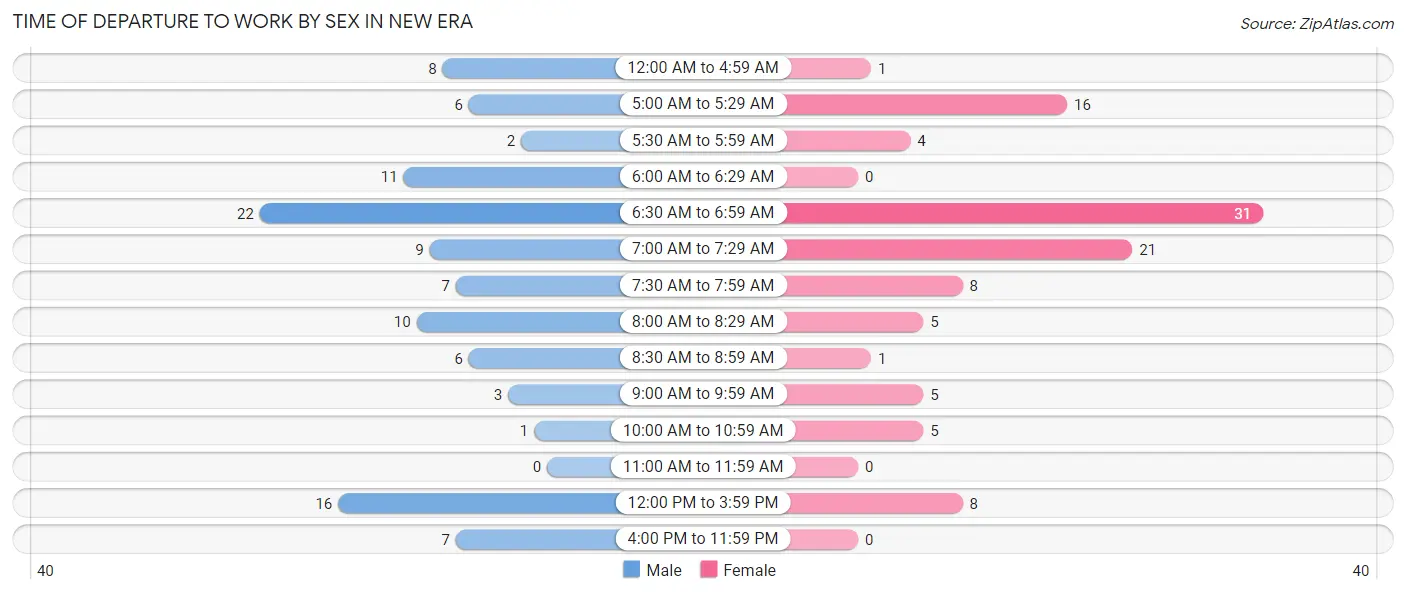
| Time of Departure | Male | Female |
| 12:00 AM to 4:59 AM | 8 (7.4%) | 1 (0.9%) |
| 5:00 AM to 5:29 AM | 6 (5.6%) | 16 (15.2%) |
| 5:30 AM to 5:59 AM | 2 (1.8%) | 4 (3.8%) |
| 6:00 AM to 6:29 AM | 11 (10.2%) | 0 (0.0%) |
| 6:30 AM to 6:59 AM | 22 (20.4%) | 31 (29.5%) |
| 7:00 AM to 7:29 AM | 9 (8.3%) | 21 (20.0%) |
| 7:30 AM to 7:59 AM | 7 (6.5%) | 8 (7.6%) |
| 8:00 AM to 8:29 AM | 10 (9.3%) | 5 (4.8%) |
| 8:30 AM to 8:59 AM | 6 (5.6%) | 1 (0.9%) |
| 9:00 AM to 9:59 AM | 3 (2.8%) | 5 (4.8%) |
| 10:00 AM to 10:59 AM | 1 (0.9%) | 5 (4.8%) |
| 11:00 AM to 11:59 AM | 0 (0.0%) | 0 (0.0%) |
| 12:00 PM to 3:59 PM | 16 (14.8%) | 8 (7.6%) |
| 4:00 PM to 11:59 PM | 7 (6.5%) | 0 (0.0%) |
| Total | 108 (100.0%) | 105 (100.0%) |
Housing Occupancy in New Era
Occupancy by Ownership in New Era
Of the total 177 dwellings in New Era, owner-occupied units account for 164 (92.7%), while renter-occupied units make up 13 (7.3%).

| Occupancy | # Housing Units | % Housing Units |
| Owner Occupied Housing Units | 164 | 92.7% |
| Renter-Occupied Housing Units | 13 | 7.3% |
| Total Occupied Housing Units | 177 | 100.0% |
Occupancy by Household Size in New Era

| Household Size | # Housing Units | % Housing Units |
| 1-Person Household | 22 | 12.4% |
| 2-Person Household | 100 | 56.5% |
| 3-Person Household | 26 | 14.7% |
| 4+ Person Household | 29 | 16.4% |
| Total Housing Units | 177 | 100.0% |
Occupancy by Ownership by Household Size in New Era

| Household Size | Owner-occupied | Renter-occupied |
| 1-Person Household | 20 (90.9%) | 2 (9.1%) |
| 2-Person Household | 89 (89.0%) | 11 (11.0%) |
| 3-Person Household | 26 (100.0%) | 0 (0.0%) |
| 4+ Person Household | 29 (100.0%) | 0 (0.0%) |
| Total Housing Units | 164 (92.7%) | 13 (7.3%) |
Occupancy by Educational Attainment in New Era

| Household Size | Owner-occupied | Renter-occupied |
| Less than High School | 5 (62.5%) | 3 (37.5%) |
| High School Diploma | 38 (82.6%) | 8 (17.4%) |
| College/Associate Degree | 60 (100.0%) | 0 (0.0%) |
| Bachelor's Degree or higher | 61 (96.8%) | 2 (3.2%) |
Occupancy by Age of Householder in New Era

| Age Bracket | # Households | % Households |
| Under 35 Years | 16 | 9.0% |
| 35 to 44 Years | 17 | 9.6% |
| 45 to 54 Years | 23 | 13.0% |
| 55 to 64 Years | 33 | 18.6% |
| 65 to 74 Years | 55 | 31.1% |
| 75 to 84 Years | 24 | 13.6% |
| 85 Years and Over | 9 | 5.1% |
| Total | 177 | 100.0% |
Housing Finances in New Era
Median Income by Occupancy in New Era

| Occupancy Type | # Households | Median Income |
| Owner-Occupied | 164 (92.7%) | $82,500 |
| Renter-Occupied | 13 (7.3%) | $46,875 |
| Average | 177 (100.0%) | $79,688 |
Occupancy by Householder Income Bracket in New Era
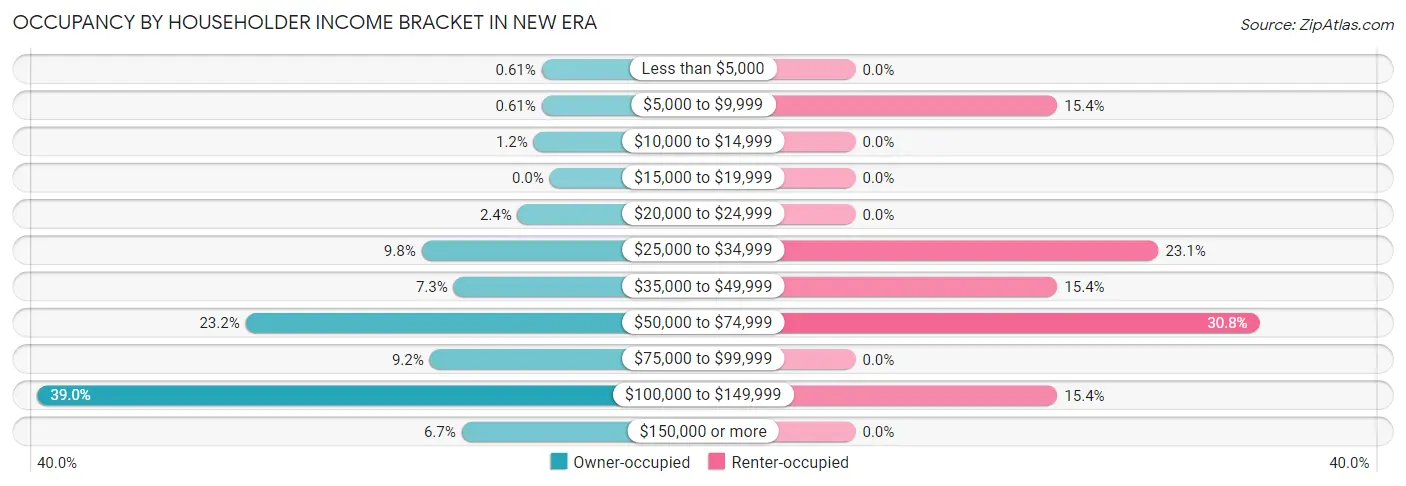
| Income Bracket | Owner-occupied | Renter-occupied |
| Less than $5,000 | 1 (0.6%) | 0 (0.0%) |
| $5,000 to $9,999 | 1 (0.6%) | 2 (15.4%) |
| $10,000 to $14,999 | 2 (1.2%) | 0 (0.0%) |
| $15,000 to $19,999 | 0 (0.0%) | 0 (0.0%) |
| $20,000 to $24,999 | 4 (2.4%) | 0 (0.0%) |
| $25,000 to $34,999 | 16 (9.8%) | 3 (23.1%) |
| $35,000 to $49,999 | 12 (7.3%) | 2 (15.4%) |
| $50,000 to $74,999 | 38 (23.2%) | 4 (30.8%) |
| $75,000 to $99,999 | 15 (9.1%) | 0 (0.0%) |
| $100,000 to $149,999 | 64 (39.0%) | 2 (15.4%) |
| $150,000 or more | 11 (6.7%) | 0 (0.0%) |
| Total | 164 (100.0%) | 13 (100.0%) |
Monthly Housing Cost Tiers in New Era

| Monthly Cost | Owner-occupied | Renter-occupied |
| Less than $300 | 9 (5.5%) | 0 (0.0%) |
| $300 to $499 | 53 (32.3%) | 0 (0.0%) |
| $500 to $799 | 32 (19.5%) | 6 (46.2%) |
| $800 to $999 | 21 (12.8%) | 3 (23.1%) |
| $1,000 to $1,499 | 41 (25.0%) | 0 (0.0%) |
| $1,500 to $1,999 | 6 (3.7%) | 2 (15.4%) |
| $2,000 to $2,499 | 0 (0.0%) | 0 (0.0%) |
| $2,500 to $2,999 | 2 (1.2%) | 0 (0.0%) |
| $3,000 or more | 0 (0.0%) | 0 (0.0%) |
| Total | 164 (100.0%) | 13 (100.0%) |
Physical Housing Characteristics in New Era
Housing Structures in New Era

| Structure Type | # Housing Units | % Housing Units |
| Single Unit, Detached | 172 | 97.2% |
| Single Unit, Attached | 0 | 0.0% |
| 2 Unit Apartments | 0 | 0.0% |
| 3 or 4 Unit Apartments | 5 | 2.8% |
| 5 to 9 Unit Apartments | 0 | 0.0% |
| 10 or more Apartments | 0 | 0.0% |
| Mobile Home / Other | 0 | 0.0% |
| Total | 177 | 100.0% |
Housing Structures by Occupancy in New Era

| Structure Type | Owner-occupied | Renter-occupied |
| Single Unit, Detached | 164 (95.4%) | 8 (4.6%) |
| Single Unit, Attached | 0 (0.0%) | 0 (0.0%) |
| 2 Unit Apartments | 0 (0.0%) | 0 (0.0%) |
| 3 or 4 Unit Apartments | 0 (0.0%) | 5 (100.0%) |
| 5 to 9 Unit Apartments | 0 (0.0%) | 0 (0.0%) |
| 10 or more Apartments | 0 (0.0%) | 0 (0.0%) |
| Mobile Home / Other | 0 (0.0%) | 0 (0.0%) |
| Total | 164 (92.7%) | 13 (7.3%) |
Housing Structures by Number of Rooms in New Era

| Number of Rooms | Owner-occupied | Renter-occupied |
| 1 Room | 0 (0.0%) | 0 (0.0%) |
| 2 or 3 Rooms | 0 (0.0%) | 3 (23.1%) |
| 4 or 5 Rooms | 23 (14.0%) | 6 (46.2%) |
| 6 or 7 Rooms | 72 (43.9%) | 2 (15.4%) |
| 8 or more Rooms | 69 (42.1%) | 2 (15.4%) |
| Total | 164 (100.0%) | 13 (100.0%) |
Housing Structure by Heating Type in New Era

| Heating Type | Owner-occupied | Renter-occupied |
| Utility Gas | 156 (95.1%) | 8 (61.5%) |
| Bottled, Tank, or LP Gas | 0 (0.0%) | 0 (0.0%) |
| Electricity | 6 (3.7%) | 5 (38.5%) |
| Fuel Oil or Kerosene | 0 (0.0%) | 0 (0.0%) |
| Coal or Coke | 0 (0.0%) | 0 (0.0%) |
| All other Fuels | 2 (1.2%) | 0 (0.0%) |
| No Fuel Used | 0 (0.0%) | 0 (0.0%) |
| Total | 164 (100.0%) | 13 (100.0%) |
Household Vehicle Usage in New Era

| Vehicles per Household | Owner-occupied | Renter-occupied |
| No Vehicle | 5 (3.0%) | 0 (0.0%) |
| 1 Vehicle | 34 (20.7%) | 10 (76.9%) |
| 2 Vehicles | 81 (49.4%) | 2 (15.4%) |
| 3 or more Vehicles | 44 (26.8%) | 1 (7.7%) |
| Total | 164 (100.0%) | 13 (100.0%) |
Real Estate & Mortgages in New Era
Real Estate and Mortgage Overview in New Era
| Characteristic | Without Mortgage | With Mortgage |
| Housing Units | 78 | 86 |
| Median Property Value | $156,500 | $171,100 |
| Median Household Income | $85,000 | $7 |
| Monthly Housing Costs | $411 | $0 |
| Real Estate Taxes | $1,606 | $0 |
Property Value by Mortgage Status in New Era

| Property Value | Without Mortgage | With Mortgage |
| Less than $50,000 | 2 (2.6%) | 2 (2.3%) |
| $50,000 to $99,999 | 19 (24.4%) | 20 (23.3%) |
| $100,000 to $299,999 | 53 (67.9%) | 62 (72.1%) |
| $300,000 to $499,999 | 4 (5.1%) | 0 (0.0%) |
| $500,000 to $749,999 | 0 (0.0%) | 2 (2.3%) |
| $750,000 to $999,999 | 0 (0.0%) | 0 (0.0%) |
| $1,000,000 or more | 0 (0.0%) | 0 (0.0%) |
| Total | 78 (100.0%) | 86 (100.0%) |
Household Income by Mortgage Status in New Era

| Household Income | Without Mortgage | With Mortgage |
| Less than $10,000 | 2 (2.6%) | 5 (5.8%) |
| $10,000 to $24,999 | 2 (2.6%) | 0 (0.0%) |
| $25,000 to $34,999 | 15 (19.2%) | 4 (4.6%) |
| $35,000 to $49,999 | 7 (9.0%) | 1 (1.2%) |
| $50,000 to $74,999 | 12 (15.4%) | 5 (5.8%) |
| $75,000 to $99,999 | 5 (6.4%) | 26 (30.2%) |
| $100,000 to $149,999 | 31 (39.7%) | 10 (11.6%) |
| $150,000 or more | 4 (5.1%) | 33 (38.4%) |
| Total | 78 (100.0%) | 86 (100.0%) |
Property Value to Household Income Ratio in New Era

| Value-to-Income Ratio | Without Mortgage | With Mortgage |
| Less than 2.0x | 42 (53.8%) | 81,875 (95,203.5%) |
| 2.0x to 2.9x | 12 (15.4%) | 47 (54.6%) |
| 3.0x to 3.9x | 15 (19.2%) | 12 (14.0%) |
| 4.0x or more | 9 (11.5%) | 9 (10.5%) |
| Total | 78 (100.0%) | 86 (100.0%) |
Real Estate Taxes by Mortgage Status in New Era

| Property Taxes | Without Mortgage | With Mortgage |
| Less than $800 | 6 (7.7%) | 0 (0.0%) |
| $800 to $1,499 | 26 (33.3%) | 3 (3.5%) |
| $800 to $1,499 | 46 (59.0%) | 18 (20.9%) |
| Total | 78 (100.0%) | 86 (100.0%) |
Health & Disability in New Era
Health Insurance Coverage by Age in New Era

| Age Bracket | With Coverage | Without Coverage |
| Under 6 Years | 14 (100.0%) | 0 (0.0%) |
| 6 to 18 Years | 57 (100.0%) | 0 (0.0%) |
| 19 to 25 Years | 34 (100.0%) | 0 (0.0%) |
| 26 to 34 Years | 33 (94.3%) | 2 (5.7%) |
| 35 to 44 Years | 29 (100.0%) | 0 (0.0%) |
| 45 to 54 Years | 62 (100.0%) | 0 (0.0%) |
| 55 to 64 Years | 66 (94.3%) | 4 (5.7%) |
| 65 to 74 Years | 89 (100.0%) | 0 (0.0%) |
| 75 Years and older | 51 (100.0%) | 0 (0.0%) |
| Total | 435 (98.6%) | 6 (1.4%) |
Health Insurance Coverage by Citizenship Status in New Era

| Citizenship Status | With Coverage | Without Coverage |
| Native Born | 14 (100.0%) | 0 (0.0%) |
| Foreign Born, Citizen | 57 (100.0%) | 0 (0.0%) |
| Foreign Born, not a Citizen | 34 (100.0%) | 0 (0.0%) |
Health Insurance Coverage by Household Income in New Era

| Household Income | With Coverage | Without Coverage |
| Under $25,000 | 21 (100.0%) | 0 (0.0%) |
| $25,000 to $49,999 | 57 (96.6%) | 2 (3.4%) |
| $50,000 to $74,999 | 104 (98.1%) | 2 (1.9%) |
| $75,000 to $99,999 | 47 (100.0%) | 0 (0.0%) |
| $100,000 and over | 206 (99.0%) | 2 (1.0%) |
Public vs Private Health Insurance Coverage by Age in New Era

| Age Bracket | Public Insurance | Private Insurance |
| Under 6 | 4 (28.6%) | 11 (78.6%) |
| 6 to 18 Years | 12 (21.0%) | 47 (82.5%) |
| 19 to 25 Years | 4 (11.8%) | 32 (94.1%) |
| 25 to 34 Years | 3 (8.6%) | 30 (85.7%) |
| 35 to 44 Years | 3 (10.3%) | 29 (100.0%) |
| 45 to 54 Years | 5 (8.1%) | 57 (91.9%) |
| 55 to 64 Years | 19 (27.1%) | 53 (75.7%) |
| 65 to 74 Years | 89 (100.0%) | 60 (67.4%) |
| 75 Years and over | 51 (100.0%) | 35 (68.6%) |
| Total | 190 (43.1%) | 354 (80.3%) |
Disability Status by Sex by Age in New Era

| Age Bracket | Male | Female |
| Under 5 Years | 0 (0.0%) | 0 (0.0%) |
| 5 to 17 Years | 2 (8.3%) | 0 (0.0%) |
| 18 to 34 Years | 2 (5.1%) | 0 (0.0%) |
| 35 to 64 Years | 9 (11.1%) | 9 (11.3%) |
| 65 to 74 Years | 7 (16.3%) | 7 (15.2%) |
| 75 Years and over | 11 (47.8%) | 7 (25.0%) |
Disability Class by Sex by Age in New Era
Disability Class: Hearing Difficulty

| Age Bracket | Male | Female |
| Under 5 Years | 0 (0.0%) | 0 (0.0%) |
| 5 to 17 Years | 0 (0.0%) | 0 (0.0%) |
| 18 to 34 Years | 0 (0.0%) | 0 (0.0%) |
| 35 to 64 Years | 2 (2.5%) | 7 (8.7%) |
| 65 to 74 Years | 2 (4.6%) | 2 (4.3%) |
| 75 Years and over | 9 (39.1%) | 4 (14.3%) |
Disability Class: Vision Difficulty

| Age Bracket | Male | Female |
| Under 5 Years | 0 (0.0%) | 0 (0.0%) |
| 5 to 17 Years | 0 (0.0%) | 0 (0.0%) |
| 18 to 34 Years | 0 (0.0%) | 0 (0.0%) |
| 35 to 64 Years | 4 (4.9%) | 0 (0.0%) |
| 65 to 74 Years | 4 (9.3%) | 0 (0.0%) |
| 75 Years and over | 0 (0.0%) | 0 (0.0%) |
Disability Class: Cognitive Difficulty

| Age Bracket | Male | Female |
| 5 to 17 Years | 2 (8.3%) | 0 (0.0%) |
| 18 to 34 Years | 2 (5.1%) | 0 (0.0%) |
| 35 to 64 Years | 3 (3.7%) | 7 (8.7%) |
| 65 to 74 Years | 0 (0.0%) | 2 (4.3%) |
| 75 Years and over | 4 (17.4%) | 2 (7.1%) |
Disability Class: Ambulatory Difficulty

| Age Bracket | Male | Female |
| 5 to 17 Years | 2 (8.3%) | 0 (0.0%) |
| 18 to 34 Years | 0 (0.0%) | 0 (0.0%) |
| 35 to 64 Years | 2 (2.5%) | 2 (2.5%) |
| 65 to 74 Years | 3 (7.0%) | 3 (6.5%) |
| 75 Years and over | 0 (0.0%) | 3 (10.7%) |
Disability Class: Self-Care Difficulty

| Age Bracket | Male | Female |
| 5 to 17 Years | 2 (8.3%) | 0 (0.0%) |
| 18 to 34 Years | 2 (5.1%) | 0 (0.0%) |
| 35 to 64 Years | 0 (0.0%) | 0 (0.0%) |
| 65 to 74 Years | 0 (0.0%) | 1 (2.2%) |
| 75 Years and over | 1 (4.3%) | 0 (0.0%) |
Technology Access in New Era
Computing Device Access in New Era

| Device Type | # Households | % Households |
| Desktop or Laptop | 150 | 84.8% |
| Smartphone | 145 | 81.9% |
| Tablet | 124 | 70.1% |
| No Computing Device | 13 | 7.3% |
| Total | 177 | 100.0% |
Internet Access in New Era

| Internet Type | # Households | % Households |
| Dial-Up Internet | 0 | 0.0% |
| Broadband Home | 131 | 74.0% |
| Cellular Data Only | 20 | 11.3% |
| Satellite Internet | 16 | 9.0% |
| No Internet | 17 | 9.6% |
| Total | 177 | 100.0% |
New Era Summary
New Era is a small unincorporated community located in Oceana County, Michigan. It is situated in the northwest corner of the county, approximately 10 miles from the county seat of Hart. The community is located on the shores of Lake Michigan and is home to a population of approximately 1,000 people.
History
The area that is now New Era was first settled in the late 1800s by a group of Dutch immigrants. The immigrants were attracted to the area due to its proximity to Lake Michigan and the abundance of natural resources. The settlers established a small fishing village and named it New Era. The village quickly grew and by the early 1900s, it had become a popular tourist destination.
In the 1920s, the village was incorporated as a village and the first mayor was elected. The village continued to grow and by the 1950s, it had become a popular summer destination for tourists from all over the Midwest.
Geography
New Era is located in the northwest corner of Oceana County, Michigan. It is situated on the shores of Lake Michigan and is approximately 10 miles from the county seat of Hart. The village is surrounded by rolling hills and is home to a variety of wildlife, including deer, foxes, and coyotes.
The climate in New Era is typical of the Midwest, with hot summers and cold winters. The average temperature in the summer is around 75 degrees Fahrenheit and the average temperature in the winter is around 25 degrees Fahrenheit.
Economy
The economy of New Era is largely based on tourism. The village is home to a variety of attractions, including a beach, a marina, and a golf course. The village also has a number of restaurants, bars, and shops.
In addition to tourism, the village is also home to a number of small businesses, including a grocery store, a hardware store, and a gas station. The village also has a post office and a library.
Demographics
As of the 2010 census, the population of New Era was 1,000. The racial makeup of the village was 97.2% White, 0.7% African American, 0.3% Native American, 0.2% Asian, and 1.6% from other races. The median household income was $37,500 and the median age was 43.
Conclusion
New Era is a small unincorporated community located in Oceana County, Michigan. It is situated on the shores of Lake Michigan and is home to a population of approximately 1,000 people. The economy of the village is largely based on tourism and it is home to a variety of attractions, including a beach, a marina, and a golf course. The racial makeup of the village is 97.2% White, 0.7% African American, 0.3% Native American, 0.2% Asian, and 1.6% from other races. The median household income was $37,500 and the median age was 43.
Common Questions
What is Per Capita Income in New Era?
Per Capita income in New Era is $37,162.
What is the Median Family Income in New Era?
Median Family Income in New Era is $83,750.
What is the Median Household income in New Era?
Median Household Income in New Era is $79,688.
What is Income or Wage Gap in New Era?
Income or Wage Gap in New Era is 42.0%.
Women in New Era earn 58.0 cents for every dollar earned by a man.
What is Inequality or Gini Index in New Era?
Inequality or Gini Index in New Era is 0.31.
What is the Total Population of New Era?
Total Population of New Era is 441.
What is the Total Male Population of New Era?
Total Male Population of New Era is 215.
What is the Total Female Population of New Era?
Total Female Population of New Era is 226.
What is the Ratio of Males per 100 Females in New Era?
There are 95.13 Males per 100 Females in New Era.
What is the Ratio of Females per 100 Males in New Era?
There are 105.12 Females per 100 Males in New Era.
What is the Median Population Age in New Era?
Median Population Age in New Era is 53.8 Years.
What is the Average Family Size in New Era
Average Family Size in New Era is 2.7 People.
What is the Average Household Size in New Era
Average Household Size in New Era is 2.5 People.
How Large is the Labor Force in New Era?
There are 240 People in the Labor Forcein in New Era.
What is the Percentage of People in the Labor Force in New Era?
61.9% of People are in the Labor Force in New Era.
What is the Unemployment Rate in New Era?
Unemployment Rate in New Era is 1.7%.